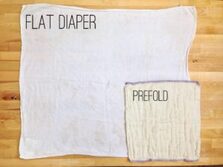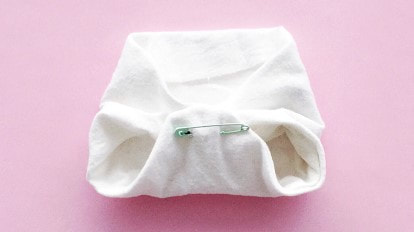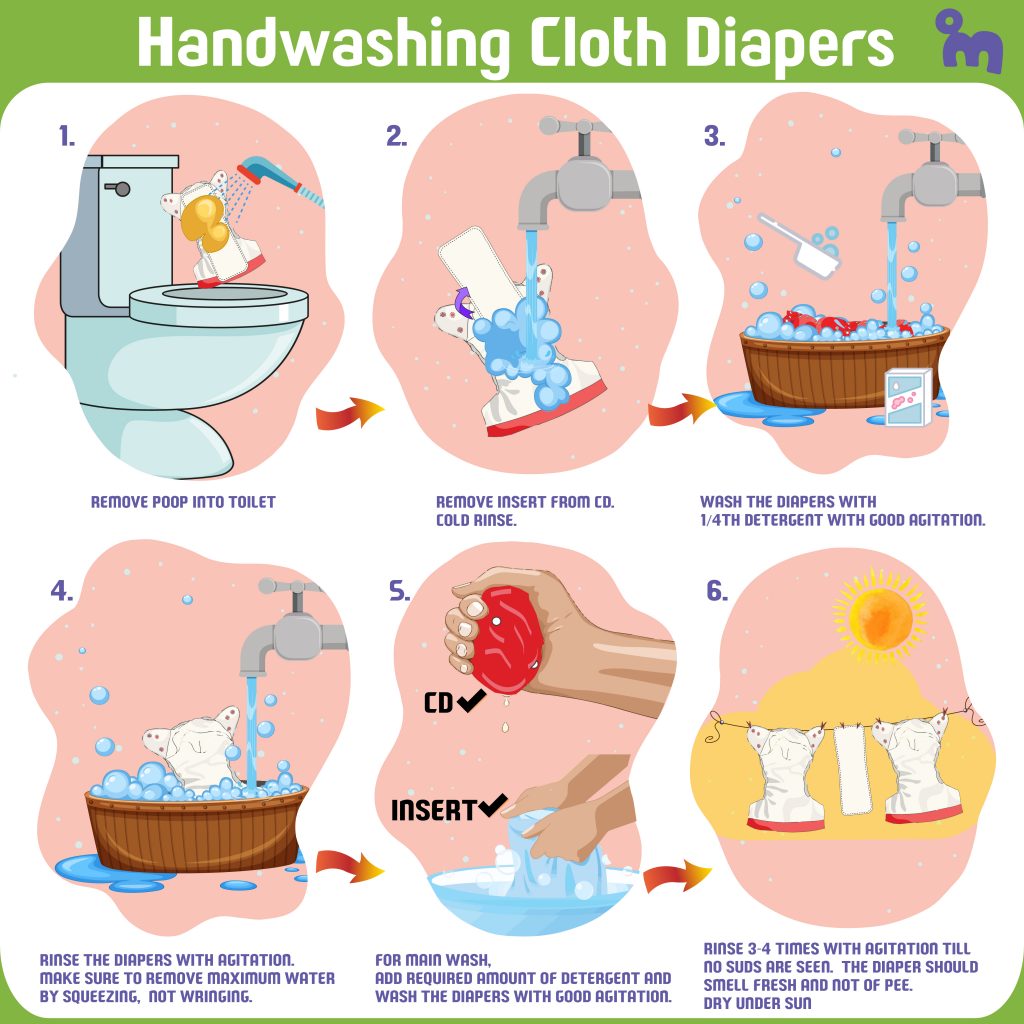
Cotton dish towels can be turned into what cloth diaperers call “flats” in variety of ways but the easiest is to “padfold” meaning folding the towel into half, half again, and then often into half a final time or even thirds, depending on the size of the towel. (This blog shows what various cloth diaper options exist and this blog provides tutorials on folding flats.) The larger the towel you use will make it more absorbent, but also bulkier. You will have to experiment to find what works for your baby. The padfold is then tucked into a waterproof cloth diaper cover, which can be found online or by asking in the local Moms group if anyone has any they aren’t using. You will need a few of them in order to rotate them out between changes, and in order to have time to wash the ones that are used for poops. With a pee, you can simply rinse out in warm water with a splash of baby wash and hang dry. It is more of a skill, but provides better coverage, if you slightly fan out the back of the padfold in order to mimic the shape of a disposable diaper. This will help better contain poop.
Old cotton T-shirts can also be turned into cloth diapers, but with more work. They are often too bulky to simply fold unless you have a larger baby or they are a smaller shirt. However, the sleeves can often be cut off and then the rest of the material folded in order to create something similar to the padfolded flat. Again, it is important to water test your material before you attempt this as a diaper. You may have to cut it down to size in order to fit your baby if they are very young. (Here's a blog and another blog that shows how to fold using a T-shirt.)
Machine Wash
Soiled diapers can be placed into a lined trash can or a bucket and need to be washed at least twice a week. If washing in a machine, washing requires two cycles and is most successful when you have an extra rinse on the machine. The first cycle is intended as an industrial rinse. It’s best done on cold with a small amount of detergent, and an extra rinse. Then, do a hot wash with the most water available for your machine, and add an extra rinse if possible. You will use detergent up to the 3rd line for this wash. Diapers go in the dryer or hung dry until completely dry, and should smell like clean laundry when done. If you have any “barnyard animal smell” or ammonia smell it, it means that the diapers are not actually fully clean and that load requires another wash.
The most widely available detergents that work to clean cloth diapers are Tide, Gain, Purex, and Arm & Hammer. I had not yet discovered Persil when I cloth diapered my kids but I would assume that would also work. Using bleach will degrade the laminate layer of the covers over time and make small cracks which will result in leaks.
Hand Wash and Dry
From Penniless Parenting: "And if, unfortunately, you don't have laundry facilities at home, you can still cloth diaper your kid- it'll just be a bit more work. Diapers can be washed in bathtubs with plungers, boiling water, and if need be, your hands. (Wear rubber gloves to make this less gross.) It's what they did in the olden days, and while annoying (and somewhat gross), can save you lots of money in the long run if it allows you to cloth diaper even without a washer and dryer. Line dry your clothes to dry, either on a foldable indoor cloths rack, or even from clothes lines hanging from your windows (if such a thing isn't against city ordinances where you live)."

Diapers can be simply folded and tucked into the cover, or they can be safety pinned in place. Pinning has a learning curve but you will get it within a day or two. If you place your finger behind the area where you are pinning, if you go too far you will poke yourself instead of your baby. I would suggest trying to find the cloth diaper safety pins as they are larger and also have a better locking mechanism so it doesn’t open while your child is moving. If you have a cover with a good fit, there is no need to pin as the snug cover will hold the diaper in place. You can find pins at Target, Amazon, Bed, Bath and Beyond, JoAnn's Fabrics, and other similar stores, usually. (Here's a tutorial on pinning the diapers.)
Some tips: make sure the diaper is fully tucked within the outer cover or it will “wick” into clothing and make clothing damp. Cloth diapers need to be changed more regularly than disposable diapers so you will need to become more aware of when wetting or soiling has happened. If you still have some disposable diapers left, they are best used for overnight and rationed as it’s not easy to find a cloth diaper that can make it a full night. Lastly, it’s a learning curve to get it perfect and don’t worry if you need some practice.
WIPES:
You can buy a cloth wipe solution for moistening wipes, or you can make your own easily.
Simple homemade cloth wipe solution
- 4 oz of water
- 1 teaspoon baby shampoo
- 1 teaspoon olive oil
- a few drops of lavender essential oil



 RSS Feed
RSS Feed